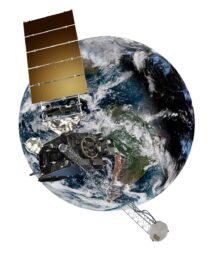NOAA’s next constellation could reveal more than weather
By Debra Werner

The National Oceanic and Atmospheric Administration plans to do more than improve forecasts with its next generation of geostationary weather satellites. The constellation scheduled to begin launching in 2032 is expected to carry instruments to monitor coastal ocean conditions and air quality.

“We need to do the weather forecasting better, but there are also emerging needs for air quality and ocean color measurements,” said Pam Sullivan, NOAA program director for Geostationary Operational Environmental Satellite-R Series (GOES-R) and Geostationary Operational Environmental Satellite-Extended Observations, or GEO-XO.
Still, weather forecasting will be GEOXO’s primary mission.
Under the current plan, which is beginning to take shape but has yet to be approved, the GEO-XO constellation would include satellites over the Eastern and Western United States like the current GOES-R series plus a third satellite over the center of the United States.
The primary instrument for the GEOWest and GEO-East satellites would be updated imagers to provide continuous observation of the United States, Mexico, Central America, South America, the Caribbean and much of the Pacific and Atlantic Oceans. L3Harris Technologies and Raytheon Intelligence & Space are performing design studies of next-generation imagers for NOAA under contracts awarded in April.
Like their predecessors, GOES-West and GOES-East, the GEO-West and GEO-East satellites would carry lightning mappers and space weather instruments. In addition, ocean-color sensors to monitor coastal areas and identify harmful algal blooms would be mounted on the satellites.
“Beach closures due to harmful algal blooms didn’t happen two decades ago but now they happen hundreds of times a year,” Sullivan said.
The GEO-XO-Central satellite would carry a different suite of instruments: a hyperspectral infrared sounder, an atmospheric composition sensor and a not-yet-selected partner payload.
If approved, GEO-XO-Central would fly NOAA’s first operational hyperspectral sounder in geostationary orbit. To date, NOAA’s hyperspectral sounders have circled the globe on polar-orbiting satellites. Sounders staring down from geostationary orbit, would provide “a lot more data to feed into numerical weather models,” Sullivan said.
It’s not yet clear exactly how large an impact the additional data would have on weather forecasts. When additional atmospheric temperature, pressure and moisture data is paired with updated models running on powerful computers, meteorologists should be better equipped to understand severe storms as they happen and to improve weather forecasts from hours to days into the future, Sullivan said.
The atmospheric composition sensor would be another first for NOAA’s geostationary constellation. Air quality forecasts are a growing concern for NOAA “due to a better understanding of the health impacts of poor air quality, and also because of increasing risks such as smoke from frequent wildfires in the Western United States,” Sullivan said. By mounting the new sensor on the GEO-XO-Central satellite, NOAA could improve air quality forecasts and help to clarify links between air quality and climate, she added.
The proposed GEO-XO-Central satellite also has room for an additional payload. NOAA plans to purchase three spacecraft of the same design. Under the current plan, GEO-XO-Central has two instruments while the GEO-East and GEO-West satellites have three.
“We will be looking for something that is complementary and enhances our mission,” Sullivan said. “We’ll be looking for weather-related or environmental-related payloads.”
As NOAA officials refine plans for the future constellation, the agency is preparing to launch GOES-T, the third satellite in the GOES-R Series, in December on a United Launch Alliance Atlas 5 rocket. The final satellite in the GOES-R Series, GOES-U, is scheduled to launch in 2024. No launch vehicle has yet been selected for GOES-U.
This article, which originally appeared in the May 2021 issue of SpaceNews magazine, was corrected to say that NOAA has not selected a launch vehicle for GOES-U.
June 3, 2021 at 10:31PM
via SpaceNews read more...

Post a Comment